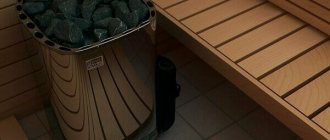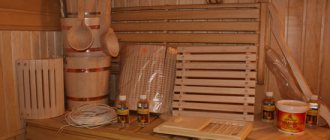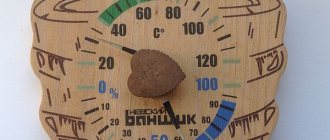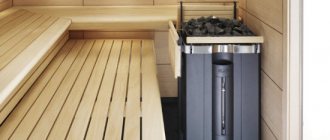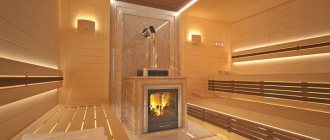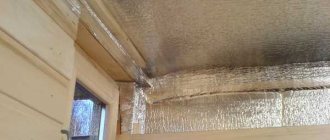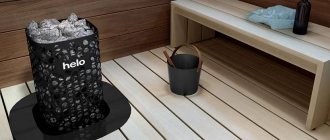Electrical wiring for baths and saunas
The main condition when choosing an energy cable is its thermal stability. It is also very important to remember that it is prohibited to install sockets in steam rooms. As for the installation of wiring in the bathhouse and steam room, due to high humidity it is necessary to create grounding.
When choosing wiring, you need to know about the main categories of premises available in the buildings in question:
- rooms with standard temperature conditions, in which you can get by with simple wiring, like in residential buildings;
- rooms where it is permissible to use only a heat-resistant cable for a bath, since the temperature in them reaches almost 170 degrees Celsius. The same cable should be used to operate an electric oven.
TYPES AND TYPES OF TEXTILE PROTECTION RVD
Protection of high-pressure hoses (high-pressure hoses), cables and pipelines, depending on the material of production and the nature of the method of neutralizing the effects of adverse factors, can be divided into several types. Moreover, the same type of RVD protection can perform several functions simultaneously.
Most often, a “ protective sleeve ”
Due to the fact that this product was not previously used in the post-Soviet space, the RVD protection does not have a specific name and may have the following names: heat-resistant sleeve, thermal sleeve, thermal protective sleeve, protective thermal sleeve, cable protective sleeve, RVD thermal protection sleeve, RVD protection, thermal cover, pyrocover, thermal protective cover, protective casing for high-pressure motors, thermal protection of cables, textile protection of high-pressure motors, fabric protection of high-pressure motors, hose cover, etc.
MATERIALS FOR PRODUCTION OF PROTECTIVE SLEEVES FOR CABLE, RVD
For the production of textile protective sleeves for cables and hoses, several types of materials are used, depending on the operating conditions:
Heat-resistant hoses: DTG.40, DTG.51, DTG.53, DTG.80, DTG.85.
Protective sleeves for cables and hoses from abrasion : DTG.01, DTG.02, DTG.03, DTG.85, DTG.90.
Acid-resistant protective sleeves for cables and hoses or covers: DTG.85, DTG.90.
Characteristics of materials for the production of textile protection RVD are presented in the section:
Production materials
For the production of plastic protective spirals, wear-resistant polymer plastics are used. Plastic RVD Protection can be produced in black and yellow colors.
For the production of metal protective spirals, steel from spring wire is used.
Wiring in rooms with standard temperature conditions
In such rooms it is recommended to use the following types of cables:
- AVVG;
- VVG;
- NYM;
- PVS.
Each of the above types of cables can be mounted surface-mounted or hidden. The only condition for their use is careful insulation of the cables, since the structure of the bathhouse or sauna itself is built from wood. Used for insulation: polyvinyl chloride, cross-linked polyethylene and other polymer materials.
Suitable for connecting lighting fixtures:
- PPGng-HF 3*1.5;
- VVGng-LS 3*1.5;
- NYM 3*1.5.
The cross-section of wires for connecting sockets should have an area of 2.3 square millimeters.
Cable connection methods
Do-it-yourself wiring in a bathhouse is done in two ways:
- Airy. This method of laying cables along the street is characterized by relative cheapness, high speed of the process and moderate labor intensity.
- Underground. Here you will have to spend more effort, time and money on installing a power supply line. But the underground wiring method guarantees the safety of the cable from mechanical influences, vandals, etc.
A power cable is first connected to the building box.
Wiring throughout the building itself can be laid open or closed. This is allowed by the standards. In the first case, it is important to perform retro wiring in the bathhouse. This is a cable stretched over internal walls using special fasteners.
Wiring in steam rooms
The steam compartments can only use heat-resistant sauna wire that can withstand elevated temperatures. If the cable insulation undergoes deformation under thermal influence, there will be a risk of fire.
The following types of cables can be purchased on the domestic market for steam rooms:
- RKGM 1*2.5;
- PVKV 1*2.5;
- PRKS 3*2.5;
- PMTK 3*2.5.
As for foreign manufacturers, it is best to use Olflex Heat 3*2.5 cable for installation. But its main disadvantage is its high cost, which significantly increases the demand for domestically produced products.
ADVANTAGES AND DISADVANTAGES OF TEXTILE PROTECTION STRUCTURES FOR HOV AND CABLE
There are no design features in the arsenal of metal and plastic spiral protections. But in the designs of fabric protective sleeves for cables and hoses, there are several parameters that determine the design features of the product:
- Material used
- Number of layers in a protective textile sleeve
- Presence/absence of a detachable connection and its type.
- Dimensions of hose protection hoses
Textile protection of high pressure hoses can be made with an internal nominal diameter of at least 20 mm. At the same time, if the required hose or cable is less than 16 mm in diameter, you can also order thermal protection for the hose and cable. In this case, the sleeve will be made with a diameter of 20 mm, and the distance between the cable and the inner diameter of the thermal protective sleeve will be slightly larger than with the usual standard size. This will not in any way affect the performance of the cable or the performance characteristics of the cable protective sleeve and hose.
BENEFITS FROM PURCHASING TEXTILE PROTECTION RVD OUR PRODUCTION
- HVD protection is manufactured individually, exactly to the size of the equipment.
- Cheaper than Pyrojacket hose, especially on medium and large diameters.
- High wear resistance of textile protection of high pressure hoses and cables.
- Quick access to equipment due to the use of detachable RVD protection with Velcro (Velcro tape).
- Reusable.
- Possibility of manufacturing textile protection for complex branch configurations.
Installation of electrical wiring and devices
Before installing a heat-resistant cable for baths and saunas, it is necessary to calculate the power that is required for the operation of all objects that consume electrical energy. Based on this, the heat-resistant cable for the sauna must have an appropriate cross-section that can withstand such a load.
A power of 1-2 kilowatts is enough to directly operate the lighting system. It will increase when installing additional accessories. Baths powered by an electric stove require at least 10 kilowatts of power to operate.
When installing any functional element that consumes electrical energy in a bathhouse or sauna, you must remember the safety rules and turn off the electricity supply.
The purchase of power cables, sockets, switches and lighting fixtures should be made in specialized stores to minimize the risk of purchasing defective products. There, sellers, taking into account the structural features of the bathhouse or sauna, can help draw up an installation diagram. It will be enough to provide high-quality photos of all premises.
PROTECTIVE TEXTILE THERMAL SLEEVE
A heat-resistant sleeve or protective textile thermal sleeve is intended to protect hose hoses, cables and technical pipelines from the effects of temperature, both in the form of convective heat and thermal radiation, and from the pinpoint impact of splashes of hot metal, welding spatter.
For the manufacture of heat-resistant sleeves (thermal sleeves), various types of heat-resistant technical fabrics are used. These materials can be made from aramid fabrics (DTG.85) with various types of coatings: silicone-containing, to prevent exposure to metal splashes and hot particles during welding, aramid fabrics coated with aluminum foil (DTG.80), which can reflect up to 95 % IR radiation.
Quite often, SiO2 fabrics, called glass fabrics and silica fabrics, are used to make thermal sleeves. Most often, heat-resistant sleeves made of fiberglass with silicone coating (DTG.40) are used. Thermal sleeves made from this type of fabric are used at temperatures up to 450 °C.
Thermal protective sleeve made of silica fabric coated with silicone or polyurethane (DTG.51), used at temperatures up to 1000 °C.
Sometimes a combination of different materials is used to ensure maximum efficiency in protecting high-pressure hoses and cables.
Heat-resistant protective sleeves can also be designated by such terms as: thermal sleeve, protective sleeve for cables, thermal protective sleeve, textile cable protection, thermal protection for high-pressure hoses, textile protection for high-pressure hoses, etc. All these names refer to the same product.
Textile thermal protection for hose hoses can increase the service life of hose hoses several times and minimize repair costs.
The thermal hose offered by our company is selected individually according to the size of the Customer’s equipment and depending on the working environment conditions and the maximum possible temperatures.
TYPES OF PROTECTIVE THERMAL SLEEVES FOR CABLE, RVD ACCORDING TO OPERATING CONDITIONS
Cable protective sleeve, single-layer RVD
Cable protective sleeve, single-layer - is made of one layer of fiberglass with a silicone coating. Used under moderate thermal influences: constant temperature up to 250 °C and peak increase up to 550 °C, without intense exposure to metal splashes.
Cable protective sleeve, two-layer RVD
Cable protective sleeve, two-layer - made of an inner layer of glass fabric with a silicone coating and a layer of silica fabric with a polyurethane coating on the outside. There is also the option of making an outer layer of silica fabric with a polyurethane coating and an inner layer of silica fabric up to 2mm thick.
Multilayer protective thermal sleeve for high pressure hoses, cables and pipelines
Multi-layer protective thermal hose for high pressure hoses, cables and pipelines - made from several layers of different fabrics. The combination of layers is determined by the operating conditions of the protective sleeve. Usually used under the combined influence of several negative external factors. This type of RVD protection is used under extreme thermal loads and temperatures up to 1100 °C, with intense exposure to metal splashes, slag, and welding spatter. Thanks to the two-layer design, a thermos effect is created inside the sleeve, which prevents overheating and destruction of the hose material (cable). Two layers of fabric also provide better resistance to mechanical stress, particularly abrasion.
TYPES OF CABLE PROTECTIVE SLEEVES, RVD ACCORDING TO EQUIPMENT PARAMETERS
According to the equipment parameters - the need for a connector at the heat-resistant sleeve for cables and high-pressure hoses:
- protective sleeve for cables, hoses and pipelines, detachable ,
- protective sleeve for cables, hoses and pipelines (without connector) .
Laying wiring
It was already mentioned above that cables in a bathhouse or sauna can be laid either openly or hidden under various protective elements. The closed method is preferable, but there are nuances here too.
According to GOST standards for working with electrical wiring, cables cannot be laid in metal tubes and corrugations. Also, metal sheathed cables must not be used. The reason for this ban is that the metal is susceptible to corrosive effects when exposed to moisture.
Electrical voltage in the sauna
Bathhouse owners often have a question: what voltage to choose? You don’t have to rack your brains and use normal household voltage, i.e. 220v.
However, for this it is necessary to fulfill certain conditions:
- Electrical wiring lines must be protected with differential circuit breakers or RCDs.
- The power supply must be made with the TN-CS grounding system.
- The bathhouse must have a SUP potential equalization system.
If for some reason the conditions listed above are not met, then it is necessary to supply the voltage in the bath through a step-down transformer, for example, you can use YaTP-0.25 220/36V
A step-down transformer
Note! The step-down transformer must be located outside the sauna room.
Installation of sockets and switches
After the heat-resistant cable for the sauna has been laid, you can begin installing sockets and switches. It was said above that these elements of the electrical network can be used throughout the entire building except the steam room itself.
It is also unacceptable to install distribution panels in rooms with high humidity. In addition to steam rooms, the same ban applies to showers. All other rooms in the house can be equipped with electrical network components without any restrictions.
Installation of lighting system
Also, when the heat-resistant wire for the sauna is laid, you can begin installing lighting fixtures. It is unacceptable to use standard lamps and light bulbs for the same reason as with an energy cable. Increased importance and temperature will lead to rapid failure of these elements.
The luminaires used must be sealed so that moisture and steam entering do not increase the risk of short circuiting and, as a result, fire. Also, if the lamp is heated unevenly, if steam gets under the lampshade, it may burst, which can lead to injury to visitors (read: “Which lamps for saunas and baths are the most practical and safe”).
When installing the lighting system, it is necessary to take into account that the lighting of the steam rooms should not be too bright. Usually matte lampshades with screwed-in 60-watt light bulbs are used.
What is heat resistant cable
Heat-resistant cable can withstand temperatures up to 200 degrees and humidity up to 100%
. Heat-resistant wire is what craftsmen call a separate type of cable product. It is characterized by increased resistance to high levels of humidity, subject to regular high temperatures.
The peculiarity of this cable is that it has an additional protective braiding made of non-flammable materials. These cables are used in facilities with extremely high temperatures: hot shops, saunas, baths, bakeries, etc.
There are several types of heat-resistant wires for saunas. They all differ in the range of temperatures they can withstand. Each of them has its own special marking.

